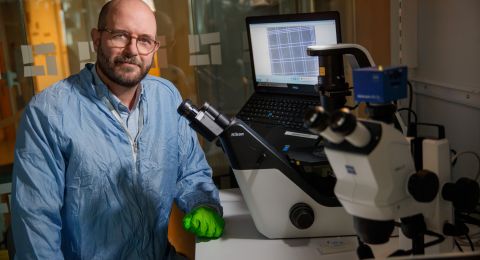Schizophrenia is in many respects a complex hereditary disease, but it is not predetermined, explains Wallenberg Scholar Jens Hjerling Leffler. Even if someone has certain risk genes, it is not certain they will develop the disease. But what determines whether or not they do?
Jens Hjerling Leffler
Professor of Molecular Psychiatry
Wallenberg Scholar
Institution:
Karolinska Institutet
Research field:
How studies of adolescent brain development can aid our understanding of the genetic and biological mechanisms that increase the risk of developing schizophrenia.
Why do some people develop schizophrenia – a severe psychotic disease?
Hjerling Leffler and his research team at Karolinska Institutet (KI) will be studying this mystery over the next five years.
In most cases a large number of risk genes are assumed to be involved in development of the disease, which is termed a polygenic disease. Only in 3–5 percent of cases is a specific mutation thought to be the cause of schizophrenia.
The researchers assume that minor changes in how much the genes are used or expressed in brain cells increase the risk of disease. But schizophrenia is highly complex, and more knowledge is needed.
Some neurons use many risk genes
Hjerling Leffler’s team has discovered that most risk genes are primarily used by certain types of neurons in the brain.
They will now be using molecular methods, lab experiments on mice and analyses of human brain tissue and of patient cases to find potential explanations.
But alongside genetic risks, environmental factors may also play a part in schizophrenia and determine who develops the disease. Hjerling Leffler says that these include growing up in a city, being a refugee, being born in the winter months, and use of cannabis.
Focusing on the young brain
Generally speaking, schizophrenia starts in the late teens or early adulthood. It is detected when the first symptoms appear. Hjerling Leffler’s team’s main focus is an in-depth study of what happens to neural cells as the adolescent brain develops.
“I believe that adolescent brain development is a key factor, where schizophrenia is caused by these processes going awry,” he says.
His choice of research field was influenced by Linnaeus, who gave plants and animals scientific names and systemized them.
“He is one of my sources of inspiration. This might be because I like cataloging and an orderly approach to science. Something that bothered me early on when I began research in neuroscience was that no one was really sure what building blocks or cell types existed in the brain,” Hjerling Leffler recalls.
In partnership with Sten Linnarsson, professor of molecular system biology at KI, Hjerling Leffler began to map brain cells using single-cell RNA sequencing, a new method that enables large-scale sequencing of the genes used by brain cells.
They then created the world’s first large-scale molecular brain cell catalog, a major innovation, published in Science in 2015.
Ongoing research around the world has revealed there to be some 5,000 different cell types in the brain.
Strenuous efforts are being made to identify exactly which genes increase the risk of schizophrenia. Some 200–300 genes of this kind have so far been found.
“We’re identifying more, and estimate that there may be around 800–900 risk genes in total,” says Hjerling Leffler.
I believe that adolescent brain development is a key factor, where neural misfiring causes schizophrenia
Examining processes in depth
His research team will be taking a closer look at what happens in the prefrontal-cortex in young people, along with three processes that are suspected of increasing the risk of schizophrenia.
The first of them concerns cell specialization during adolescence.
“We have found that certain neurons in the pre-frontal cortex undergo specialization during adolescence. We want to know what causes them to do so,” Hjerling Leffler says.
Other questions are: How is the specialization triggered and controlled? Does it occur via properties inside the cells or perhaps due to electrical activity in the surrounding neural network? Can something here go wrong, causing schizophrenia in adolescence?
The next process concerns the importance of transcription factors. These are proteins that control which genes are activated. Current knowledge mostly relates to the function these factors have before we are born.
The KI researchers’ hypothesis is that these proteins are “recycled” by the brain during adolescence in order to control the synapses – the link between neurons – and their stability.
The third process, which may play a part in development of schizophrenia, concerns the logic underlying RNA splicing. This is a molecular process that enables different proteins to be formed from the same gene. This sometimes occurs via RNA-binding proteins.
Hjerling Leffler explains that his team has observed that these proteins are more numerous in patients suffering from schizophrenia.
“We know the splicing machinery is more active in conjunction with schizophrenia, and we want to find out why this and what the implications are,” he says.
He points out that an overarching aim of seeking biological explanations for schizophrenia is to find new ways of treating the disease, and therapies that can be used at an early stage.
“Our hypothesis is that studies of the mechanisms underlying adolescent brain development are essential in order to understand how the devastating symptoms arise,” Hjerling Leffler adds.
Text Monica Kleja
Translation Maxwell Arding
Photo Magnus Bergström






